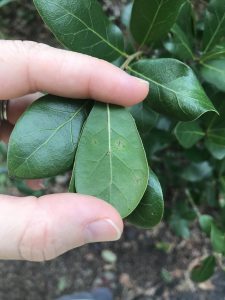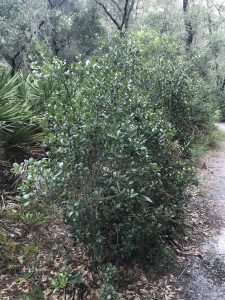There are 26 species of oaks vouchered in Florida, 10 of which have been found in Pinellas County. While oaks are often known for being these massive trees, did you know we have four species of scrubby/shrubby oaks that don’t look much like trees at all? These are: chapman oak (Quercus chapmanii), running oak (Quercus pumila), dwarf live oak (Quercus minima), and myrtle oak (Quercus myrtifolia). Ever heard of them? When hiking among these species, it’s easy to overlook them (figuratively and literally), but even at heights of just three feet in the case of the running oak and dwarf live oak, you can spot acorns that give away their identity, at least as an oak. Today we are going to focus on the chapman oak and the myrtle oak; you’ll have to stay tuned for “The Little Oaks Part II” to learn about the other two species.
First things first. Did you know there are two separate groups of oaks referred to as red oaks and white oaks? Knowing some key features of these groupings can help narrow down the species you are trying to identify. In the case of chapman oak and myrtle oak, they fall into different groups. Chapman oaks are white oaks and myrtle oaks are red oaks. Okay, stay with me here…

According to L. Katherine Kirkman, Claud L. Borwn, and Donald J. Leopold’s “Native Trees of the Southeast: An Identification Guide” key characteristics to look for include:
White Oaks
In the summer look for:
- Leaves lacking bristle tips
- Acorns that mature at the end of the first growing season
- Glabrous inner surface of acorn (can use a knife to open the shell)
In the winter look for:
- Lack of presence of immature acorns
- Light gray or whitish bark (on most species)
Red Oaks
In the summer look for:
- Leaves with bristle tips
- Acorns that mature in the second growing season
- Silky pubescence on inner surface of acorn (can use a knife to open the shell)
In the winter look for:
- Presence of immature acorns
- Dark gray to black bark
So now let’s look at the difference between these two species:
Chapman Oak (Quercus chapmanii)
Only found in a small region of central and north Florida, chapman oaks typically only grow to about nine feet tall. Look for this scrubby tree in dry pineland habitats. Note the light brown, scaly bark of chapman oak, a common feature among the broader group of white oaks…remember? The leaves are alternate, simple, stiff and leathery up to 3.5 inches long and 1-1.5 inches wide, with an obtuse tip, being wider towards the top half of the leaf. The leaves are a shiny, dark green above and pale below with entire (smooth) leaf margins and can vary from un-lobed to lobed (almost wavy in appearance). If acorns are present, they will be about ¾ of an inch long with almost half of the acorn encapsulated by the cup. And if it’s a white oak, will the inner surface of the acorn be shiny or hairy? Yup, shiny, you got it! Leaves are considered tardily deciduous, meaning they will hang on until winter or early spring before falling.
![Bruce Kirchoff from Greensboro, NC, USA [CC BY 2.0 (https://creativecommons.org/licenses/by/2.0)] Light brown, scaly bark of chapman oak.](https://blogs.ifas.ufl.edu/pinellasco/files/2019/07/Quercus_chapmanii_bark-23814770629-199x300.jpg)
![Bruce Kirchoff from Greensboro, NC, USA [CC BY 2.0 (https://creativecommons.org/licenses/by/2.0)] Overall appearance of a chapman oak.](https://blogs.ifas.ufl.edu/pinellasco/files/2019/07/Quercus_chapmanii_overall-tree-23790581999-199x300.jpg)
![Bruce Kirchoff from Greensboro, NC, USA [CC BY 2.0 (https://creativecommons.org/licenses/by/2.0)] Leaves of a chapman oak.](https://blogs.ifas.ufl.edu/pinellasco/files/2019/07/Quercus_chapmanii_24158500895-300x199.jpg)
![Bruce Kirchoff from Greensboro, NC, USA [CC BY 2.0 (https://creativecommons.org/licenses/by/2.0)] Acorn of a chapman oak.](https://blogs.ifas.ufl.edu/pinellasco/files/2019/07/Quercus_chapmanii_acorn-24162672636-300x199.jpg)
Myrtle Oak (Quercus myrtifolia)
Myrtle oak can be confused with chapman oak because they grow in the same parts of the state, in similar habitats, and in a similar fashion – a shrubby thicket anywhere from five up to 30 feet tall. Leaves of the two species are also similar in that they are alternate, simple, and leathery with entire margins. Where they differ is the myrtle oak leaves are evergreen, more oval, sometimes elliptical in shape and generally smaller in size, less than two inches long and one inch wide. Unlike the potential lobes found on the tip of chapman oak leaves, the tips of myrtle oaks are rounded and may have a bristle-tip (a common feature among red oaks). While the leaf margins of myrtle oak are entire, they are typically also revolute, folding under along the edges. Leaves are a shiny dark green on the top and underside, and smooth on both surfaces.
A distinguishing characteristic of the underside of the myrtle oak leaf is something we, in-house, call “hairy armpits”. Sorry, I know, but now you won’t forget it 😉 What we mean by this is, in the intersections of the veins on the underside of the leaf, especially along the mid-rib, you will see tiny tufts of hair. The bark of myrtle oak is smooth and brown, unlike the lighter brown, scaly bark of chapman oak. And lastly, acorns of myrtle oak are smaller and more rounded, only about ½ inch long with the cup only enclosing about a quarter of the nut. Oh, and guess what you’ll find on the inner surface of the nut? Yup, tons of tiny little hairs!
![Bruce Kirchoff from Greensboro, NC, USA [CC BY 2.0 (https://creativecommons.org/licenses/by/2.0)] Myrtle oak leaves.](https://blogs.ifas.ufl.edu/pinellasco/files/2019/07/Quercus_myrtifolia_leaves-24059932412-300x199.jpg)


![Bruce Kirchoff from Greensboro, NC, USA [CC BY 2.0 (https://creativecommons.org/licenses/by/2.0)] Myrtle oak tree showing acorns.](https://blogs.ifas.ufl.edu/pinellasco/files/2019/07/Quercus_myrtifolia_acorns-24176542726-300x199.jpg)
 1
1
